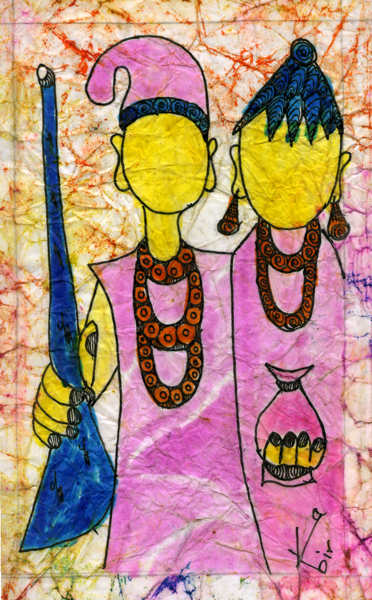Ogun
God of Iron

In Yoruba mythology, Ogun is a primordial Orisha whose first appearance was as a hunter named Tobe Ode. He is said to be the first of the Orisha to descend to the realm of Ile Aiye (the earth) to find suitable habitation for future human life.
In commemoration of this one of his praise names (Oriki), is Osin Imole or the "first of the primordial Orisha to come to Earth". Ogun was most likely first worshiped by the Yoruba people of West Africa.
He is worshiped in places like Ekiti, Oyo, Osun and Ondo States. He is believed to have (wo ile sun) which means to sink into the ground not to die, in a place named Ire-Ekiti. Through out his entire life he fought for the people of Ire.
In Dahomey mythology, Gu is the god of war and patron deity of smiths and craftsmen. He was sent to earth to make it a nice place for people to live, and he has not yet finished this task.
In Santeria and Palo Mayombe, he has been syncretized with Saint Peter.
In the religious tradition of the Afro-Brazilian Candomble, Ogum (as this Yoruba divinity is known in the Portuguese language) is often identified with Saint George, for example in the state of Rio Grande do Sul. However, Ogun may also be represented by Saint Sebastian, as it is often done in the northeast of the country, for example in the state of Bahia.
Officially Saint Sebastian is the patron saint of the city of Rio de Janeiro, state of Rio de Janeiro, Brazil. According to anthropologist Luiz Mott, Saint Sebastian is also considered by many homosexuals, especially those belonging to the lower and marginalized classes, as the patron saint of gay people.
In all his incarnations Ogun is a fiery and martial spirit. He can be very aggressively masculine much like the spirit Shango but can also rule the head of female, or effeminate male initiates to whom he takes a liking. He is also linked with blood, and is for this reason often called upon to heal diseases of the blood.
In the cult of Orishas, he appears in other aspects, such as Ogun Akirun, Ogun Alagbede, Ogun Alara, Ogun Elemona, Ogun Ikole, Ogun Meji, Ogun Oloola, Ogun Onigbajamo, Ogun Onire, Ogun-un, Onile, the latter being a feminine incarnation.
Other mythologies
In Haitian Vodou and Yoruba mythology, Ogun (or Ogoun, Ogum, Ogou) is a loa and orisha, who presides over fire, iron, hunting, politics and war. He is the patron of smiths and is usually displayed with his attributes: gun, machete or sabre, and rum. He is one of the husbands is a husband of Osun and Oya in Yoruba mythology.
Ogun is the traditional warrior and seen as a powerful deity of metal work, similar to Ares and Hephaestus in Greek mythology and Visvakarma in Hindu mythology, he is represented with Saint George in Brazil. As such Ogun is mighty, powerful, triumphal, yet also exhibits the rage and destructiveness of the warrior whose strength and violence can turn against the community he serves. Perhaps linked to this theme is the new face he has taken on in Haiti which is not quite related to his African roots, that of a powerful political leader.
He gives strength through prophecy and magic. It is Ogun who is said to have planted the idea, led and given power to the slaves for the Haitian Revolution of 1804. He is called now to help people obtain a government more responsive to their needs. Contents
Aspects of Ogun comes to mount people in various aspects of his character, and the people are quite familiar with each of them. Some of these aspects are:
Ogun the wounded warrior. He assumes a Christ-figure pose which the people know well from their Christian associations.
Ogun Feraille. He gives strength to the servitors by slapping them on the thighs or back.
Ogun Badagris. He may lift a person up and carry him or her around to indicate his special attention and patronage. To all the aspects of Ogun there is the dominant theme of power and militancy. His possessions can sometimes be violent.
Those mounted by him are known to wash their hands in flaming rum without suffering from it later. They more
A.K.A.'S Inspiration Art
Documenting past and present events for the next Generations.
